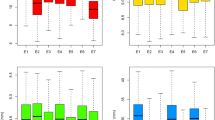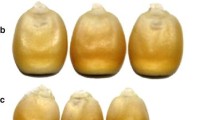Abstract
Kernel filling is an important factor that directly affects kernel yield in maize. Based on a Logistic model, the process of kernel filling in maize can be effectively fitted, and the characteristic parameters with biological significance can be estimated. To clarify the genetic mechanism of characteristic parameters of kernel filling in maize, a recombinant inbred line (RIL) population including 208 lines derived from the maize inbred lines DH1M and T877 were evaluated in Nantong in 2015 and in Yangzhou in 2016, respectively. The kernel dry weights of recombinant inbred lines were measured 10, 15, 20, 25, 30, 35, 40, 43, 46, 49, 52, 55, 58 and 61 days after pollination (DAP). A total of 12 characteristic parameters related to kernel filling were estimated in different environments using the Logistic model. These parameters showed abundant phenotypic variation across two environments in the recombinant inbred line population. Some more ideal genotypes were selected through clustering based on BLUP values of characteristic parameters. Genetic analysis indicated that the 12 characteristic parameters conformed to the “major gene plus polygenes” model. The results of two environments were reproduced well. Most of the characteristic parameters related to kernel filling were controlled by two major genes, and a few characteristic parameters were controlled by three or four major genes. In addition, the genetic models of some characteristic parameters differed in the two environments due to interactions between the genes and environments. This study not only laid a foundation for further clarifying the genetic mechanism of maize kernel filling and mapping the related genes but also suggests a new paradigm for dynamic developing traits.




Similar content being viewed by others
References
Bauer AM, Reetz TC, Léon J (2006) Estimation of breeding values of inbred lines using best linear unbiased prediction (BLUP) and genetic similarities. Crop Sci 46:2685–2691
Borrás L, Zinselmeier C, Senior ML, Westgate ME, Muszynski MG (2009) Characterization of grain-filling patterns in diverse maize germplasm. Crop Sci 49:999–1009
Cao X, Liu B, Zhang Y (2013) SEA: a software package of segregation analysis of quantitative traits in plants. J Nanjing Agric Univ 36:1–6
Eichenberger S, Miguez F, Edwards J et al (2015) Changes in kernel filling with selection for grain yield in a maize population. Crop Sci 55:1–6
Ershkov S (2011) Logistic equation of human population growth (generalization to the case of reactive environment). BMC Med Genomics 6(1):39
Gai JY (2005) Segregation analysis of genetic system of quantitative traits in plants. Hereditas 27:130
Gasura E, Setimela P, Edema R, Gibson PT, Okori P, Tarekegne A (2013) Exploiting grain-filling rate and effective grain-filling duration to improve grain yield of early-maturing maize. Crop Sci 53:2295–2303
Gelang J, Pleijel H, Sild E et al (2010) Rate and duration of grain filling in relation to flag leaf senescence and grain yield in spring wheat (Triticum aestivum) exposed to different concentrations of ozone. Physiol Plant 110(3):366–375
Jongkaewwattana S, Geng S (2001) Inter-relationships amongst grain characteristics, grain-filling parameters and rice (Oryza sativa L.) milling quality. J Agron Crop Sci 187:223–229
Kass RE et al (1990) Nonlinear regression analysis and application. Technometrics 23(3):309
Kordestani R et al (2009) Yield potential assessment of different Iranian sesame landraces under various levels of Iron in Jiroft. J Plant Ecophysiol 1(2):85–90
Liu ZH, Ji HQ, Cui ZT, Wu X, Duan LJ, Feng XX, Tang JH (2011) QTL detected for grain-filling rate in maize using a RIL population. Mol Breed 27:25–36
Löffler CM et al (2005) Classification of maize environments using crop simulation and geographic information systems. Crop Sci 45:1708–1716
Maydup ML, Antonietta M, Guiamet JJ, Graciano C, López JR, Tambussi EA (2010) The contribution of ear photosynthesis to grain filling in bread wheat (Triticum aestivum L.). Field Crop Res 119:48–58
Mo HD (1993) Genetic analysis for qualitative-quantitative traits I. The genetic constitution of generation populations and the identification of major gene genotypes. Acta Agron Sinica 19(1):1–6
Ogawa K (2012) Mathematical analysis of age-related changes in leaf biomass in forest stands. Can J For Res 42:356–363
Parvizi S et al (2009) Evaluation of different plant densities effects on grain filling rate and duration, yield and its components in pinto bean varieties. Res J Biol Sci 4(4):499–502
Pearl R, Reed LJ (1920) On the rate of growth of the population of the United States since 1790 and its mathematical representation. Proc Natl Acad Sci USA 6:275–288
Prado SA, Sadras VO, Borrás L (2014) Independent genetic control of maize (Zea mays L.) kernel weight determination and its phenotypic plasticity. J Exp Bot 65(15):4479
Sadras VO, Egli DB (2008) Seed size variation in grain crops: allometric relationships between rate and duration of seed growth. Crop Sci 48:1–8
Sun S, Frelich LE (2011) Flowering phenology and height growth pattern are associated with maximum plant height, relative growth rate and stem tissue mass density in herbaceous grassland species. J Ecol 99:991–1000
Takai T, Fukuta Y, Shiraiwa T, Horie T (2005) Time-related mapping of quantitative trait loci controlling grain-filling in rice (Oryza sativa L.). J Exp Bot 56:2107–2118
Thevenot C et al (2005) QTLs for enzyme activities and soluble carbohydrates involved in starch accumulation during grain filling in maize. J Exp Bot 56:945–958
Thornley JHM, Shepherd JJ, France J (2007) An open-ended logistic-based growth function: analytical solutions and the power-law logistic model. Ecol Model 204:531–534
Wang G, Kang MS, Moreno O (1999) Genetic analyses of grain-filling rate and duration in maize. Field Crop Res 61:211–222
Wei F, Tao H, Lin S et al (2011) Rate and duration of grain filling of aerobic rice HD297 and their influence on grain yield under different growing conditions. Scienceasia 37(2):98–104
West GB, Brown JH, Enquist BJ (2001) A general model for ontogenetic growth. Nature 413(6856):628–631
Wilhelm EP, Mullen RE, Keeling PL, Singletary GW (1999) Heat stress during grain filling in maize: effects on kernel growth and metabolism. Crop Sci 6:1733–1740
Wu R, Ma C, Chang M et al (2002) A logistic mixture model for characterizing genetic determinants causing differentiation in growth trajectories. Genet Res 79(3):235–245
Xu S (2003) Estimating polygenic effects using markers of the entire genome. Genetics 163:789
Zhang YM, Gai JY, Yang YH (2003) The EIM algorithm in the joint segregation analysis of quantitative traits. Genet Res 81:157–163
Zhang Z, Liu Z, Cui Z, Hu Y, Wang B, Tang J (2013) Genetic analysis of grain filling rate using conditional QTL mapping in maize. PLoS ONE 8:e56344
Zhang Z et al (2016) Genetic dissection of the maize kernel development process via conditional QTL mapping for three developing kernel-related traits in an immortalized F2 population. Mol Genet Genomics 291:437–454
Acknowledgements
This work was supported by Grants from the National Key Technology Research and Development Program of MOST (2016YFD0100300), the National High-tech R&D Program (863 Program) (2014AA10A601-5), the National Natural Science Foundations (31391632, 91535103 and 31601810), the Natural Science Foundations of Jiangsu Province (BK20150010), the Priority Academic Program Development of Jiangsu Higher Education Institutions, the Natural Science Foundation of the Jiangsu Higher Education Institutions (14KJA210005), and the Innovative Research Team of Universities in Jiangsu Province.
Author information
Authors and Affiliations
Corresponding author
Electronic supplementary material
Below is the link to the electronic supplementary material.
Rights and permissions
About this article
Cite this article
Yin, S., Li, P., Xu, Y. et al. Logistic model-based genetic analysis for kernel filling in a maize RIL population. Euphytica 214, 86 (2018). https://doi.org/10.1007/s10681-018-2162-y
Received:
Accepted:
Published:
DOI: https://doi.org/10.1007/s10681-018-2162-y




